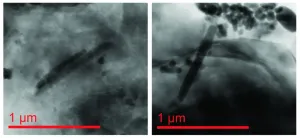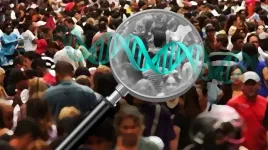(Press-News.org) Just as plants and animals on land are keenly attuned to the hours of sunlight in the day, life in the oceans follows the rhythms of the day, the seasons and even the moon. A University of Washington study finds the biological light switches that make this possible.
Single-celled organisms in the open ocean use a diverse array of genetic tools to detect light, even in tiny amounts, and respond, according to a study published Feb. 1 in the Proceedings of the National Academy of Sciences.
"If you look in the ocean environment, all these different organisms have this day-night cycle. They are very in tune with each other, even as they get moved around. How do they know when it's day? How do they know when it's night?" said lead author Sacha Coesel, a research scientist in oceanography at the UW.
Though invisible to the human eye, ocean microbes support all marine life, from sardines to whales. Knowing these communities' inner workings could reveal how they will fare under changing ocean conditions.
"Just like rainforests generate oxygen and take up carbon dioxide, ocean organisms do the same thing in the world's oceans. People probably don't realize this, but these unicellular organisms are about as important as rainforests for our planet's functioning," Coesel said.
By analyzing RNA filtered out of seawater samples collected throughout the day and night, the study identifies four main groups of photoreceptors, many of them new. This genetic activity uses light to trigger changes in the metabolism, growth, cell division, movements and death of marine organisms.
The discovery of these new genetic "light switches" could also aid in the field of optogenetics, in which a cell's function can be controlled with light exposure. Today's optogenetic tools are engineered by humans, but versions from nature might be more sensitive or better detect light of particular wavelengths, the researchers said.
"This work dramatically expanded the number of photoreceptors -- the different kinds of those on-off switches -- that we know of," said senior author Virginia Armbrust, a UW professor of oceanography.
Not surprisingly, many of the new tools were for light in the blue range, since water filters out red wavelengths (which is why oceans appear blue). Some were also for green light, Coesel said.
The researchers collected water samples far from shore and looked at all genetic activity from protists: single-celled organisms with a nucleus. They filtered the water to select organisms measuring between 200 nanometers to one-tenth of a millimeter across. These included photosynthetic organisms, like algae, which absorb light for energy, as well as other single-celled plankton that gain energy by consuming other organisms.
The team collected samples every four hours, day and night, for four days in the North Pacific near Hawaii. Researchers used trackers to follow the currents about 50 feet (15 meters) below the surface so that the samples came from the same water mass.
The study also looked at samples that came from a depth of 120 and 150 meters (400 and 500 feet), in the ocean's "twilight zone." Even there, the genetic activity showed that the organisms were responding to very low levels of sunlight.
While the sun is up, these organisms gain energy and grow in size, and at night, when the ultraviolet light is less damaging to their DNA, they undergo cell division.
"Daylight is important for ocean organisms, we know that, we take it for granted. But to see the rhythm of genetic activity during these four days, and the beautiful synchronicity, you realize just how powerful light is," Armbrust said.
Future work will look at places farther from the equator, where plankton communities are more subjected to the changing seasons.
INFORMATION:
This research was funded by the Simons Foundation and the National Science Foundation's Extreme Science and Engineering Discovery Environment program. Other co-authors are Ryan Groussman, Rhonda Morales and François Ribalet at the UW; Bryndan Durham at the University of Florida; Sarah Hu at Woods Hole Oceanographic Institution; and David Caron at the University of Southern California.
For more information, contact Coesel at coesel@uw.edu or Armbrust at armbrust@uw.edu.
There are fossils, found in ancient marine sediments and made up of no more than a few magnetic nanoparticles, that can tell us a whole lot about the climate of the past, especially episodes of abrupt global warming. Now, researchers including doctoral student Courtney Wagner and associate professor Peter Lippert from the University of Utah, have found a way to glean the valuable information in those fossils without having to crush the scarce samples into a fine powder. Their results are published in Proceedings of the National Academy of Sciences.
"It's so fun to be a part of a discovery like this, something that can be used ...
Most snakes get from A to B by bending their bodies into S-shapes and slithering forward headfirst. A few species, however -- found in the deserts of North America, Africa and the Middle East -- have an odder way of getting around. Known as "sidewinders," these snakes lead with their mid-sections instead of their heads, slinking sideways across loose sand.
Scientists took a microscopic look at the skin of sidewinders to see if it plays a role in their unique method of movement. They discovered that sidewinders' bellies are studded with tiny pits and have few, if any, of the tiny spikes found on the bellies of other snakes.
The Proceedings ...
CAMBRIDGE -- The temperature of a planet is linked with the diversity of life that it can support. MIT geologists have now reconstructed a timeline of the Earth's temperature during the early Paleozoic era, between 510 and 440 million years ago -- a pivotal period when animals became abundant in a previously microbe-dominated world.
In a study appearing today in the Proceedings of the National Academy of Sciences, the researchers chart dips and peaks in the global temperature during the early Paleozoic. They report that these temperature variations coincide with the planet's ...
In a new study led by Yale Cancer Center, researchers have discovered a novel metabolic gatekeeper mechanism for leukemia. This mechanism depends on a molecule called PON2, which could lead to a new treatment for the disease. The findings were published online today in the Proceedings of the National Academy of Sciences (PNAS).
B cells are effector cells of the adaptive immune system and are marked by low energy levels, which prevent transformation to leukemia. In this study, Yale scientists identified high expression levels of the detoxifying lactonase ...
Philadelphia, February 1, 2021 - Researchers at Children's Hospital of Philadelphia (CHOP) have demonstrated that autism spectrum disorder (ASD) may be caused by defects in the mitochondria of brain cells. The findings were published online by the Proceedings of the National Academy of Sciences.
Multiple studies have revealed hundreds of mutations associated with autism spectrum disorder, but there is no consensus as to how these genetic changes cause the condition. Biochemical and physiological analyses have suggested that deficiencies in mitochondria, the "batteries" of the cell that produce ...
Scientists have identified a group of drugs that may help stop a leading cause of vision loss after making an unexpected discovery that overturns a fundamental belief about DNA.
The drugs, known as Nucleoside Reverse Transcriptase Inhibitors, or NRTIs, are commonly used to treat HIV. The new discovery suggests that they may be useful against dry macular degeneration as well, even though a virus does not cause that sight-stealing condition.
A review of four different health insurance databases suggests that people taking these drugs have significantly reduced risk of developing dry macular degeneration, a condition that affects ...
A 15-year experiment on Arctic shrubs in Greenland lends new understanding to an enduring ecological puzzle: How do species with similar needs and life histories occur together at large scales while excluding each other at small scales? The answer to this question has important implications for how climate change might shift species' distributions across the globe.
The study was published today in the journal PNAS and led by the University of California, Davis. Its findings also reveal trends related to carbon sequestration and carbon exchange as the Arctic becomes both greener and browner.
EXPANSION AND EXCLUSION
Like lines of traffic traveling the same roads at the same time without crashing into each ...
CLEVELAND - Evidence suggests particulate matter is the air pollutant which poses the greatest threat to global health. Studies have shown that exposure to particulate matter smaller than 2.5 microns is associated with acute and chronic elevations in blood pressure (BP) as well as hypertension. In the study "The Benefits of Intensive Versus Standard Blood Pressure Treatment According to Fine Particulate Matter Air Pollution Exposure" published this week in the journal Hypertension, researchers at University Hospitals (UH) and Case Western Reserve University (CWRU) ...
A paper by a multidisciplinary team of scientists affiliated with various Brazilian institutions, including the University of São Paulo (USP) and the National Cancer Institute (INCA), shows that people of African descent are less likely to find a donor in the National Register of Voluntary Bone Marrow Donors (REDOME) than people with predominantly European ancestry. The paper is published in Frontiers in Immunology.
REDOME is the world’s third-largest bone marrow bank, with more than 5 million registered voluntary donors.
According to the study, having mainly African genetic ancestry can reduce a person’s chances of finding a donor by up to 60%, and having African copies of HLA genes, which must be compatible with ...
Obesity and its duration are significant risk factors for type 2 diabetes, cardiovascular events, multiple cancers and decreased quality of life. According to the Centers for Disease Control and Prevention, obesity affects 20.6% of adolescents ages 12-19 in the United States, meaning a potential lifetime of dealing with this condition. Complications from obesity can also result in a potentially decreased life expectancy of five to 20 years for these youth. In a new study published in Pediatrics, researchers at Children's Hospital Colorado (Children's Colorado) have found that both younger and older adolescents have similar weight loss, resolution of high blood pressure and high cholesterol, nutritional impacts and improvement in quality of life after bariatric surgery. These results ...








